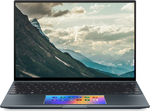A comparison of specs, key information, reviews, and best pricing from top retailers
Last updated -- hours ago | Report incorrect information
What we think

The PerfectRec laptop team Learn more
Updated January 10, 2024·
The ASUS Vivobook 14 is less expensive and has a longer battery life, which makes it a good choice for general use and portability. In contrast, the ASUS Zenbook 14X is pricier but offers a significant boost in performance due to a better processor and GPU, more RAM, and higher storage capacity, making it suitable for demanding tasks like 3D rendering, machine learning, and engineering work. The Zenbook 14X also has a higher quality display with deeper colors and a higher contrast ratio, ideal for creative work or enjoying multimedia content. Both have similar weight and screen size, but their strengths cater to different user needs. Give Feedback
this description is based on the product variant with some specs and product variant with some specs. At the time of writing, the variant with some specs cost some dollars and the variant with some specs cost some dollars.
Advantages of the ASUS Vivobook 14
- Good battery life
Advantages of the ASUS Zenbook 14X
- Good for general use
- Good for engineering and design
- Good for software development
- Good for content creation
- Very good overall display quality
- Good speakers
- Very good keyboard
Key differences
General Use
6.9


7.6
1920 x 1080
RESOLUTION
2880 x 1800
IPS
DISPLAY TECHNOLOGY
OLED
250.0 nits
DISPLAY BRIGHTNESS
339.0 nits
7.0 Hours
BATTERY LIFE
5.5 Hours
6.7/10
KEYBOARD QUALITY SCORE
8.0/10
8.5/10
PORTABILITY SCORE
8.6/10
The ASUS Zenbook 14X is good for general use, while the ASUS Vivobook 14 is only fair.
The ASUS Zenbook 14X stands out in general use over the ASUS Vivobook 14 due to its significantly superior screen quality, which includes a higher resolution OLED display and better color coverage, and a more powerful CPU and double the RAM, which greatly enhance performance. While both are equally portable, the Zenbook 14X's better keyboard and speaker quality also contribute to a more pleasant user experience, despite it having a shorter battery life than the Vivobook 14.
Gaming and AI
6.0


6.5
3.6/10
OVERALL GPU SCORE
3.9/10
1920 x 1080
RESOLUTION
2880 x 1800
60Hz
REFRESH RATE
90Hz
No
SUPPORTS DLSS
No
No
MUX SWITCH / ADVANCED OPTIMUS
No
7.5/10
FAN NOISE SCORE
6.5/10
The ASUS Zenbook 14X and ASUS Vivobook 14 are both only fair for gaming and AI, though the ASUS Zenbook 14X is somewhat better.
The ASUS Vivobook 14 has an integrated GPU and a standard screen refresh rate, which is adequate for light gaming and 3D applications but might struggle with more demanding tasks, whereas the ASUS Zenbook 14X includes a dedicated Nvidia GPU and a higher screen refresh rate, offering better performance for gaming and 3D tasks, but it'll still be limited compared to high-end gaming machines.
Engineering and Design
6.3


7.7
6.4/10
OVERALL CPU SCORE
7.9/10
3.6/10
OVERALL GPU SCORE
3.9/10
8.0 GB
RAM
16.0 GB
The ASUS Zenbook 14X is good for engineering and design, while the ASUS Vivobook 14 is only fair.
The ASUS Vivobook 14’s moderate performance is due to its mid-range CPU, integrated graphics, and basic screen quality suitable for essential tasks, contrasting with the ASUS Zenbook 14X that offers a superior CPU, dedicated GPU, and a higher-quality OLED screen for detailed engineering and design work. While they share similarities in portability and good keyboard quality, the Zenbook 14X outperforms with better screen resolution and color accuracy, making it well-suited for demanding engineering applications.
Content Creation
6.9


7.6
6.4/10
OVERALL CPU SCORE
7.9/10
1920 x 1080
RESOLUTION
2880 x 1800
8.0 GB
RAM
16.0 GB
IPS
DISPLAY TECHNOLOGY
OLED
The ASUS Zenbook 14X is good for content creation, while the ASUS Vivobook 14 is only fair.
PerfectRec’s Content Creation Score takes into account the many different features of the laptop that make it more or less suitable for photo editing, video editing and other content creation tasks.
Software Development
6.8


7.4
6.4/10
OVERALL CPU SCORE
7.9/10
8.0 GB
RAM
16.0 GB
1920 x 1080
RESOLUTION
2880 x 1800
6.7/10
KEYBOARD QUALITY SCORE
8.0/10
The ASUS Zenbook 14X is good for software development, while the ASUS Vivobook 14 is only fair.
PerfectRec’s Software Development Score takes into account the many different features of the laptop that make it more or less suitable for software developers.
Screen Quality
6.3


8.3
14.0in
SIZE
14.0in
1920 x 1080
RESOLUTION
2880 x 1800
IPS
DISPLAY TECHNOLOGY
OLED
60Hz
REFRESH RATE
90Hz
250.0 nits
BRIGHTNESS
339.0 nits
The ASUS Zenbook 14X has a better screen than the ASUS Vivobook 14 for general use, gaming and AI, engineering and design, content creation, and software development.
The ASUS Vivobook 14's display offers adequate resolution and brightness for daily tasks and productivity software, which is typically sufficient for general use and basic engineering applications, although its color gamut may not fully satisfy professional design needs. The ASUS Zenbook 14X elevates visual experiences with higher resolution and brighter screen, alongside superior color coverage, making it ideal for detail-oriented work in engineering and graphic design; however, neither laptop is optimized for gaming or 3D modeling due to their lack of high refresh rates, which are crucial for fluid motion and responsiveness in these domains.
Battery
7.0 Hours


5.5 Hours
The ASUS Vivobook 14 has 7 hours of battery life. The ASUS Zenbook 14X has 5.5 hours of battery life.
Battery life estimate is based on a mix of common use patterns. More portable and higher performing laptops tend to have less battery life.
Build Quality
7.0


7.8
The ASUS Zenbook 14X and ASUS Vivobook 14 both have good build quality, though the ASUS Zenbook 14X has somewhat better build quality.
PerfectRec’s Build Quality Score incorporates case materials, display and keyboard flex, hinge quality, and overall reliability.
Cost
$480


$777
$200
$400
$600
$800
$1,000
$1,200
The ASUS Vivobook 14 has a price of $480 and the ASUS Zenbook 14X costs $777.

Let Us Help Find Your Perfect Laptop
Find your new laptop
Key similarities
Portability
Very Good


Very Good
14.0in
SIZE
14.0in
3.0 lbs
WEIGHT
3.0 lbs
0.7in
THICKNESS
0.6in
The ASUS Zenbook 14X and ASUS Vivobook 14 both have very good portability.
The most portable laptops are small, thin, and light.
Give feedback
We’re constantly working to improve.
How the ASUS Vivobook 14 and the ASUS Zenbook 14X compare to other laptops
Spec Comparison
| ASUS Vivobook 14 | ASUS Zenbook 14X |
GENERAL | |||
|---|---|---|---|
| Price | |||
$480 | $777 | ||
Release Date | |||
Release Date | March 1, 2023 | April 1, 2022 | |
Overall Dimensions | |||
Overall Dimensions | 12.8'' x 8.4'' x 0.7'' | 12.3'' x 8.7'' x 0.67'' | |
Weight | |||
Weight | 3.09 lbs | 3.09 lbs | |
Width | |||
Width | 12.79" | 12.25" | |
Depth | |||
Depth | 8.42" | 8.71" | |
INTERNAL | |||
|---|---|---|---|
Processor | |||
Processor | Intel i5-1235U | Intel i7-1260P | |
RAM | |||
RAM | 8 GB | 16 GB | |
DDR Memory Version | |||
DDR Memory Version | 4 | 5 | |
RAM Slots | |||
RAM Slots | 1 | 0 | |
Storage | |||
Storage | 256 GB | 512 GB | |
BATTERY | |||
|---|---|---|---|
Battery Life | |||
Battery Life | 7 Hours | 5.5 Hours | |
Battery Capacity | |||
Battery Capacity | 42 Wh | 63 Wh | |
SCREEN | |||
|---|---|---|---|
Diagonal Size | |||
Diagonal Size | 14" | 14" | |
Display Technology | |||
Display Technology | IPS | OLED | |
Resolution | |||
Resolution | 1920 x 1080 | 2880 x 1800 | |
Refresh Rate | |||
Refresh Rate | 60Hz | 90Hz | |
Display Brightness | |||
Display Brightness | 250 nits | 339 nits | |
RELIABILITY, APPEARANCE & ACOUSTICS | |||
|---|---|---|---|
Build Quality Score | |||
Build Quality Score | 7/10 | 7.8/10 | |
Portability Score | |||
Portability Score | 8.5/10 | 8.6/10 | |
Gaming Laptop Appearance | |||
Gaming Laptop Appearance | No | No | |
Premium Business Laptop | |||
Premium Business Laptop | No | No | |
Fan Noise Score | |||
Fan Noise Score | 7.5/10 | 6.5/10 | |
HARDWARE FEATURES | |||
|---|---|---|---|
Keyboard Quality Score | |||
Keyboard Quality Score | 6.8/10 | 8/10 | |
Speaker Quality Score | |||
Speaker Quality Score | 6/10 | 7.5/10 | |
Webcam | |||
Webcam | 720p | 720p | |
Fingerprint Reader | |||
Fingerprint Reader | Yes | Yes | |
Backlit Keyboard | |||
Backlit Keyboard | No | Yes | |
Number Pad | |||
Number Pad | No | Yes | |
CONNECTIVITY | |||
|---|---|---|---|
USB Type-A | |||
USB Type-A | 3 | 1 | |
USB-C ports | |||
USB-C ports | 1 | 2 | |
USB-C Charging | |||
USB-C Charging | No | Yes | |
Display Outputs | |||
Display Outputs | 1 | 3 | |
Thunderbolt Version | |||
Thunderbolt Version | N/A | 4 | |
Shopping
ASUS Zenbook 14X
See more
Dig into reviews and images
NotebookCheck
Sebastian Jentsch | April 2022
"With the Zenbook 14X, Asus has a 14-incher in its range that is - mostly - a joy to use. First, there is the colorful OLED panel with 3K resolution that displays the sRGB and DCI-P3 color spaces. The Zenbook is also at the forefront in terms of workmanship, input devices and connections with 2x Thunderbolt 4 ports and a generous keyboard layout. A pleasure to use, the Zenbook 14X is a solid, very well-built subnotebook that sits well on the table. A runtime of five hours, however, is below average for a high-end subnotebook nowadays. The OLED screensaver causes increased power consumption when in idle mode."
Get a great deal on the ASUS Vivobook 14 or the ASUS Zenbook 14X
About ASUS
ASUS, a Taiwanese electronics brand, is one of the largest personal computer vendor by market share. The majority of their laptops are targeted towards personal use or gaming. Their most popular product lines include the budget-friendly VivoBook, more premium ZenBook, and their TUF and ROG gaming laptops, the latter of which has a reputation for excellent gaming performance.
Give feedback
We're constantly perfecting our model
Laptop guides you might be interested in
More comparisons for you
FAQs
FAQs about laptops
Why trust us
This information was produced and vetted by the PerfectRec laptops team. We are a product research and recommendation organization that meticulously reviews and evaluates the latest laptop information and makes it digestible for you.
By the numbers
380
Laptops evaluated
48,640
Laptops stats compiled
13
Proprietary Laptops ratings developed
173,595
Recommendations made
37,613
Consumer hours saved
About the laptop team
Joe Golden, Ph.D
CEO and Laptops Editor
Joe is an entrepreneur and lifelong electronics enthusiast with a Ph.D in Economics from the University of Michigan.
Jason Lew
Staff Expert & Software Engineer
Jason is a staff expert and software engineer that has been making laptop recommendations for 7 years and moderates one of the largest laptop subreddits.
Chandradeep Chowdhury
Staff Expert & Software Engineer
Chandradeep is a staff expert and software engineer and expert in televisions and monitors. He’s been making monitor recommendations for ten years.
Craig Russell
Laptops Expert
Craig is a UK-based laptops expert. Craig works in IT, where he recommends and supports laptops and PCs for clients and has been recommending laptops on Reddit for five years.















